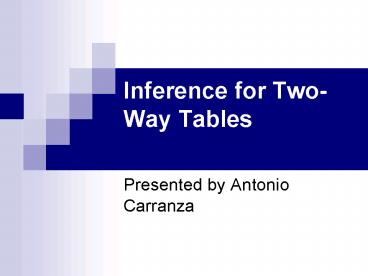Inference for TwoWay Tables PowerPoint PPT Presentation
1 / 11
Title: Inference for TwoWay Tables
1
Inference for Two-Way Tables
- Presented by Antonio Carranza
2
Inference for Two-Way Tables
- Two-Way Tables
- Relationship between Categorical Variables
- Chi-Square Test for two-way tables
3
Statistically Significant
- Analyze the kind of contingency tables by using
the Chi-Square Test. - Main goal Is to decide if the data shows a
statistical significance relationship by
performing a Significance Test.
4
Two-Way Tables (Categorical Variable)
- Two-way tables let us compare the distribution of
a categorical variable (Factor B) by (yes or no)
responses to a question between different
populations (Factor A). - Table size Rows x Columns
- Ex.
- 2 x 2
3 x 2
5
Relationship between Categorical Variables
- First step To determine if there is a
significant difference in (Factor B). State the
null hypothesis and the alternative hypothesis. - Ho the row and column variables are independent
(ex. there is no relationship between the two). - Ha the row and the column variables are
dependent.
6
Expected Cell Count
- Then In doing inferences for a table is to
figure out what the results would look like if
the distribution of the categorical variable
(Factor B) where the same in both populations
(Factor A). - Inferences procedures work in count.
- Then Calculate the expected counts for each
population in the table - .
7
Observed and Expected Counts
- The test will be based on a measure of how far
the observed table is from the expected table. - If the observed count is far different from the
expected count then we can suspect that the null
hypothesis is false. - Example observed expected
8
Factor B (Categorical Variable)
Factor A (Two different populations)
Total of observations (Table count) A1 A2
or B1 B2
9
Chi-Square Statistic
- To do the comparing and to measure how far the
expected table is from the observed table, we use
the Chi-square test statistic - Chi-square statistic is used to measure how far
the observed count is deviated from the expected
count smaller the closer the fit of the data. - Chi-square of zero means the data exactly fit the
predicted values.
10
Chi-Square Distribution
- Comparing the value of the test statistic with
the critical value for its distribution. - Unlike the Normal or t distributions, the
- distribution takes values in
0 5 10 15 20 30 40 50
11
p-Value for the Chi-Square Test
- If the observed and expected counts are very
different, will be large, indicating evidence
against Ho. - Thus, the p-value is always based on the right-
hand tail of the distribution.

